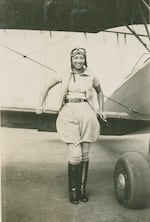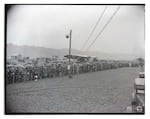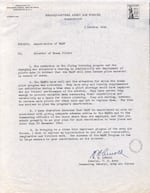Up on a hill in Portland’s River View Cemetery, with a clear view of Mount Hood, lies Hazel Ying Lee’s grave. The long flat tombstone is made of polished red-and-black granite, outlined with crumbling concrete.
Under her name is a special engraving: A diamond flanked by two wings. It’s the symbol of the WASP, or Women Airforce Service Pilots.
Lee was the first ever Chinese American woman to fly for the United States military. And she was the 38th, and last, WASP to die in service to her country.
But when her family picked out a spot for her to be buried, “[The cemetery] said no,” remembered Frances Tong, Lee’s younger sister, “Because we were Asian. And that area was not allotted for the Chinese.”
Through tears, Tong recounted the injustice and the way her elder sister, Florence Lee, fought back. “Florence is a very mild person. But this time she really gave it to them,” said Tong.
That was 1944. Today, the memory of all WASPs still face the threat of erasure under the Trump administration’s federal purge and ban on diversity, equity and inclusion, or DEI, efforts.

Screenshot from March 24, 2025 of the official US Army Website, where historical WASP content has been removed. The banner reads “Archived historical content from culturally-focused Army websites is under review for compliance with Executive and OSD policy. Content will be reposted after the review.”
Emily Hamilton / OPB
But the legacy and heroism of Lee and her WASP comrades persists.
In English, Lee’s Chinese name “英” (pronounced YING) translates to “hero.” This is the story of how she lived up to that title.
Early life

Hazel Ying Lee's passion for flying started early in her life. Before turning 20, she became one of the first women to become a member of Portland's Chinese Flying Club.
U.S. Air Force
Hazel Ying Lee was born on Aug. 24, 1912, in Portland, Oregon. The daughter of Chinese immigrants, she was a scrappy, competitive kid who enjoyed breaking the mold.
“She was always in some kind of trouble,” said Elsie Chang, Lee’s best friend.
One day when she was a teenager, Lee went with her friends to an airshow. From that moment on, she knew she had to fly.
To save money for flying lessons, Lee got a job as an elevator operator at Liebes department store downtown. At the time, it was one of the only jobs available to Chinese American women.
“Either you would be a stock girl, or an elevator operator, or you might work in the theater’s restroom, in a costume,” remembered Tong. “It was very difficult for an Asian person to find a job.”
Lee and her friends grew up under the Chinese Exclusion Act. Passed in 1882, this law was the first in U.S. history to restrict immigration based on race, and was a reflection of widespread anti-Chinese racism at the time. It made it illegal for Chinese laborers to immigrate into the U.S.
But, nothing could stop Lee. And she earned her pilot’s license before she turned 20.

In this still taken from video, two airplanes from the Erickson Aircraft Collection perform at the Airshow of the Cascades in Madras, Ore., on Aug. 23, 2024.
Jeff Kastner / OPB
World War II begins in China
Not long after Lee earned her pilot’s license, the world descended into violence.
In 1931, Japan invaded China. Known as the Mukden Incident, this marked the beginning of a long conflict that turned into one of the most brutal wars in history, and left an estimated 20 million civilians dead.

Informational illustration highlighting global events leading up to WWII in Asia.
Emily Hamilton / OPB
Eventually, the Sino-Japanese war bled into the larger conflict that became World War II. It would be another 10 years before the U.S. got involved.
Watching from afar, Lee wanted to help. And she wasn’t the only one.
Lee’s piloting skills led her to join what became known as the Portland Group: Chinese American pilots specially selected by Portland’s Chinese Consolidated Benevolent Association to train in military combat maneuvers under veteran Pacific Northwest pilot Al Greenwood.
Their ultimate goal? Travel to China and volunteer to join the Chinese air force.
Cultural convergence
But why did a group of Chinese Americans in Portland, Oregon, turn to flight as a way to help China?
A few things converged: Aviation became culturally important to China and Chinese Americans as a symbol of modernity and a path towards the future. This was encouraged by prominent Chinese leaders like Sun Yat-Sen, who founded the Republic of China.
He coined the phrase “aviation to save the nation.”

Informational illustration of Sun Yat-Sen that highlights his quote, "aviation to save the nation."
Emily Hamilton / OPB
Meanwhile, Oregon had become an early hub of American aviation. It was the first state in the country to develop a State Board of Aeronautics in 1921.
Basically, aviation was just popular here. The Oregonian newspaper had an aviation editor, and there were multiple airports within miles of downtown. So, going to airshows would have been a pretty common experience for Portlanders at the time.

Spectators at Swan Island airport during Portland’s second annual air circus, probably taken on June 10, 1928.
Oregon Historical Society
This was also before aviation became a legitimate profession, so rules and stereotypes around who could or couldn’t be a pilot weren’t really written yet.
Because of all this, three of the first four Chinese American women to earn a pilot’s license in the U.S. were all from Portland: Leah Hing, Virginia Wong and Hazel Ying Lee.
Traveling to China
Armed with advanced training and a passion for flight, Lee and her friends left the U.S. and traveled to China in 1932. But, despite a need for pilots, women were not allowed to fly.
Eventually, Lee’s family and best friend Elsie Chang joined her in Guangzhou, formerly known as Canton. And they were in the city when it was bombed by invading Japanese forces.
“She was running around looking for hiding places for all of us … where are we gonna hide from the bombs? They were just dropping like mad,” remembered Chang.
In the chaos, they escaped to Hong Kong, about 100 miles southeast of Guangzhou. Lee felt powerless. There was nothing she could do as a war refugee, so she came back to New York and tried to find a different way to help.
Soon, Lee would find another opportunity to serve closer to home.
American heroes
After the Japanese attack on Pearl Harbor, the U.S. was fighting in Europe and the Pacific. And there was a shortage of pilots.
So, a woman named Jacqueline Cochran proposed an idea for a new pilot training program that would enlist women and train them to fly to support the war effort.
These pilots eventually became known as the WASP: Women Airforce Service Pilots. As soon as Lee learned about the program, she applied and got in — becoming the first ever Chinese American woman to fly for the United States military.
WASPs served on bases across the country and worked long hours, seven days a week. They were often the first to fly planes right off the assembly line.
They also transported old, war-weary planes to stations where they could be repaired. WASPs tested aircraft, ferried supplies and trained other pilots.
And Lee was the best of the best — one of around 100 women (out of more than a thousand) who qualified to fly the most high powered fighters.
Lee was a natural leader in the WASP and well loved by her comrades. She was well known for her kindness, wit, humor, skill and tenacity.

Hazel Ying Lee, left, wears her WASP uniform and stands with her comrades in front of a car, around 1943.
Texas Woman's University
Hazel’s untimely death
The military considered the WASP “civilian employees” even though they wore the same uniforms, went through the same training and were expected to follow orders just like an enlisted soldier.
The nature of flying the newest, oldest and recently repaired planes made forced landings a pretty common experience in the WASP.
Lee only had two forced landings in her career. The first time, her engine failed over a field in Kansas. She landed safely and was able to call for help.
In late 1944, Lee was beginning her descent to an airfield in Great Falls, Montana, when she got an order over the radio to pull up.
Another plane above her was coming in for a landing at the same time. The two planes were too close for safety.
Lee pulled up. The pilot above her received the same order. But his radio was broken, and he never got the message.
The two planes collided in the air.
Lee survived the initial crash and was pulled from the burning wreck. She was rushed to a nearby military hospital, but her injuries were too severe.
On Nov. 25, 1944, Lee became one of the last WASP to die in service. She was 32 years old.
Three days later, Lee’s family received another telegram. Lee’s younger brother Victor Lee, a soldier in the U.S. Army, had died in combat in Europe.
“Within two days [Victor] also died,” said Tong through tears, “within two days of each other in France, in a tank.”
Chang was in Portland when she learned of Hazel’s death. “I couldn’t believe it,” she remembered. “Hazel was such a good flyer… I couldn’t sleep for days thinking about her.”
Cemetery conflict
Less than a month after Lee’s death, the WASP were disbanded.

Memo from U.S. Army Commanding General Hap Arnold to Jacqueline Cochran instructing her to deactivate the WASP, sent on Oct. 1, 1944.
Eisenhower Presidential Library
Lee was not honored with a military funeral and she did not receive veteran benefits. The U.S. Military would not even pay to transport Lee’s body home.
So Lee’s family brought her back to Portland. They picked out a spot for her to be buried on a hill overlooking the Willamette River.
“[Florence] applied and they said they couldn’t sell it to her because we are Chinese,” explained Tong, “and the cemetery in that area was not allotted for the Chinese … Florence is a very mild person. But this one time she really gave it to them. She says, ‘they died in the war for America for the United States, and they are entitled to it. And should it not be, she would go to the War Department.‘”
Lee is buried next to her brother. The shield of Athena — symbol of the WASP — is engraved on her tombstone.
Enduring legacy
It took more than three decades, but in 1977, President Jimmy Carter finally recognized the WASP and granted them veteran status and benefits.
And in 2010, over half a century later, all WASPs received the congressional gold medal for their “service, record, and revolutionary reform in the Armed Forces.”
“Hazel was always so cool,” recalled Chang, who witnessed the way Hazel longed to be seen for who she truly was.
“Hazel, give it time,” she said, “you will be recognized for all your determination, I believe in that.”

Illustrated collage of Hazel Ying Lee.
Emily Hamilton / OPB

Learn more about how World War II impacted Oregon:
- Oregon at War (broadcast in 2007)
Correction: A previous version of this story stated that Hazel Ying Lee was the 38th and last WASP to die in service on Nov. 25, 1944. It was later discovered that two other WASPs from Washington state died shortly after Lee. Those pilots were Katherine Applegate Keeler Dussaq, who died on Nov. 26, 1944, and Mary Louise Webster who died on Dec. 9, 1944. OPB regrets the error. To learn more about Webster, you can visit the Kittitas County Historical Museum.
